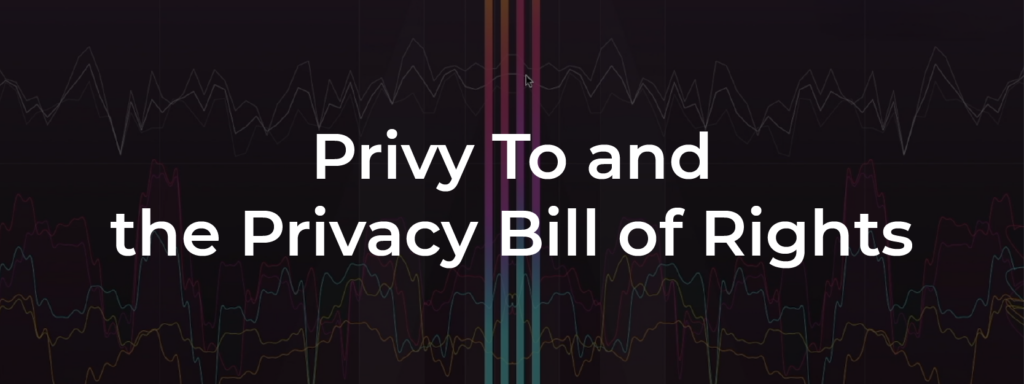
Privy To is a series of immersive installations and XR projects first conceived in 2019 and created by Michelle Leddon, with the help of producers Julia Scott-Stevenson and co-sponsored by Least Authority. It was an official selection at the Copenhagen Documentary Film Festival 2021.
In a recent Medium piece titled “Field Notes: Why We Let Our Privacy Bill of Rights Die,” Leddon placed Privy To in the historical context of privacy rights, articulated the vision behind the project, and explained the decision to forgo one of the project’s aims: creating a Privacy Bill of Rights for XR.
Privy To is “an attempt to get people thinking about privacy as a living concept with a human history and evolution,” said Leddon, “aimed to explore the evolution of privacy rights.”
The live conceptualization of Privy To, conceived with the help of EEG composer and technologist Jason J. Snell, would see participants wearing EEG headsets as they watched a video on the history of privacy rights and reflect on what might be the next stage in privacy’s evolution. In so doing, they would “navigate with their minds through a conceptual evolution of privacy with the help of biofeedback and dynamic projections of their brain waves.”
As an adjustment for the Covid-19 era, Snell wore the headset and participants watched and listened to his brain as he moved through the three stages of the installation, “Isolation,” as he reflects alone, “Intimacy,” as he carries out a private exchange with another human being, and “Exposure,” as he is exposed to an audience. This process allowed participants to reflect on three facets of privacy rights: the right to private thought, intimate communications, and public exposure.
Historical Context
To understand the importance and ambitions of Privy To, it is important to place it in the historical context of privacy rights. Below is a brief summary (for a more detailed overview, see Leddon’s article):
In 1890, lawyers Samuel Warren and Louis Bearnstean published one of the most influential essays in the history of American law: ‘The Right to Privacy.’ Building on a concept whose roots can be traced back to Aristotle’s distinctions of private and public spaces, the text defined “protection of the private realm as the foundation of individual freedom in the modern age.”
Like a breach in a dam wall, the essay unleashed a powerful current of discussions and debates around privacy – and ushered in a new field of law. In the past half century or so, discourse around privacy intensified in legislatures around the world as more bills came into law. But while great advances have been made, progress in privacy legislation (as with most things) is not linear or universal. Even within the confines of liberal debates, the values of privacy and free speech can cause friction, as there is disagreement about where one should start and the other should end.
In the past 30 years these debates have expanded to the digital realm, with growing numbers of people alarmed by the monetization of personal data and the far-reaching influence of the Web 2 tech behemouths. This growing awareness of digital rights is resulting in more calls for companies and governments to safeguard the rights of individuals, whether it is through encryption mechanisms to shield personal data, or regulatory action to punish companies for eschewing data protection laws. As new Web 3 technologies emerge, like the metaverse and augmented reality (XR), we have an opportunity to break from the reactive stances of the past and proactively define the rights, norms and architecture of the contemporary Internet.
This is where Privy To and the Privacy Bill of Rights for XR comes in.
Privacy Bill of Rights
Beyond encouraging participants to engage with the concept of privacy and understand its place within human evolution, the project aimed to encourage discussion about privacy rights in the digital age with the aim of creating a Privacy Bill of Rights for XR.
After watching Snell via Zoom explore with three facets of privacy, audiences were brought into a group discussion with the Privacy Bill of Rights for XR represented on a spreadsheet with playful, JPEG aperitifs to stimulate a relaxed, friendly environment. Discussions ensued about what should go into such a bill, with the organizers offering suggestions for audiences to upvote or downvote.
Ultimately, efforts to create a bill were dropped due to a lack of enthusiasm among participants, which Ledden suggests was due to the format taken.
Despite this, Leddon echos calls made by others in the Web 3 movement: “(While) XR landscapes, universes or any other future space constructed for social interaction” proliferate, there is a clear need to re-examine privacy in the digital world and its “importance as a social good,” and not only a matter of individual liberty.
“We have to take privacy in the digital world seriously,” Leddon concludes. “It is time to reimagine, redefine and find a new narrative for privacy and we can do this, as it has been done before, by reassembling the lessons of the past.”
At Least Authority, we believe that privacy matters. We are committed to building and supporting the development of usable technology solutions and ethical business practices to advance digital security and preserve privacy as a fundamental human right. Read here about our ongoing contributions to Web 3.
